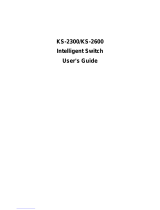
2: Product Overview
XPress-Pro SW 94000 User Guide 13
Aging
The Xpress-Pro SW 94000 switch performs the aging process for the <MAC addresses,
VLAN> pair in the switching database. Once a <MAC address, VLAN> pair is aged out,
the SDB is modified.
Spanning Tree
The Xpress-Pro SW 94000 switch supports one Spanning Tree per bridged
network.VLAN
A virtual LAN (VLAN) is a network of computers that behave as if they are connected to
the same wire, even though they may actually be physically located on different
segments of a LAN. VLANs are analogous to a group of end stations, perhaps on
multiple physical LAN segments that are not constrained by their physical location and
can communicate as if they were on a common LAN.
VLANs are configured through software rather than hardware, which makes them
extremely flexible. One of the biggest advantages of VLANs is that when a computer is
physically moved to another location, it can stay on the same VLAN without any
hardware reconfiguration.
Because VLANs are not limited by the hardware constraints that physically connect
traditional LAN segments to a network, they can define a network into various logical
configurations. For example, VLANs can define a network by application. In this scenario,
a company might create one VLAN for multimedia users and another for email users.
VLANs can also define a network by department. For example, a company might have
one VLAN for its Engineering Department, another for its Marketing Department, and
another for its Account Payable Department.
VLANs can also be set up according to the organization structure within a company. For
example, the company president might have his/her own VLAN, the executive staff might
have a different VLAN, and the remaining employees might have yet a different VLAN.
As these examples show, VLANs offer unparalleled flexibility. The following sections
describe how deploying VLANs can benefit organizations and reduce administration
costs.
Broadcast Containment
In traditional networks, traffic broadcasts to all network devices, whether they are the
intended recipients or not. However, VLANs can be set up to contain only those devices
that need to communicate with each other. As a result, VLANs significantly reduce
network congestion. In addition, VLANs prevent broadcast storms from causing network
meltdown due to volumes of traffic.
Multicast-Based Multimedia Applications
Multimedia applications, such as interactive training, video conferencing, and news-video
transmissions, require large amounts of bandwidth. These applications are also
extremely sensitive to variable delays, which are unavoidable on a shared Ethernet
network. By defining a VLAN based on the IP multicast address for all subscribing
members on the VLAN, sufficient bandwidth will be available for these application,
providing true multimedia on Ethernet.





















